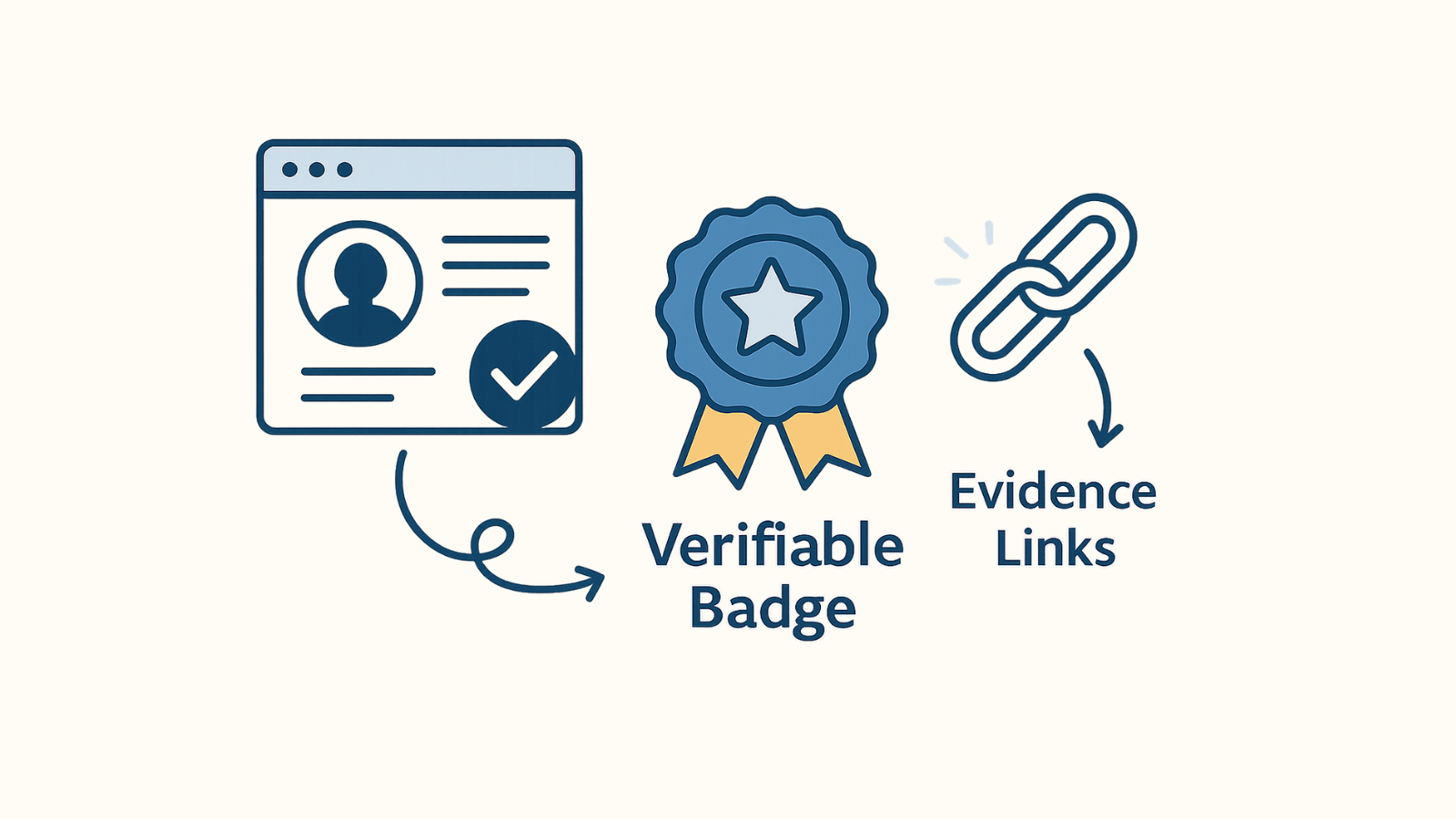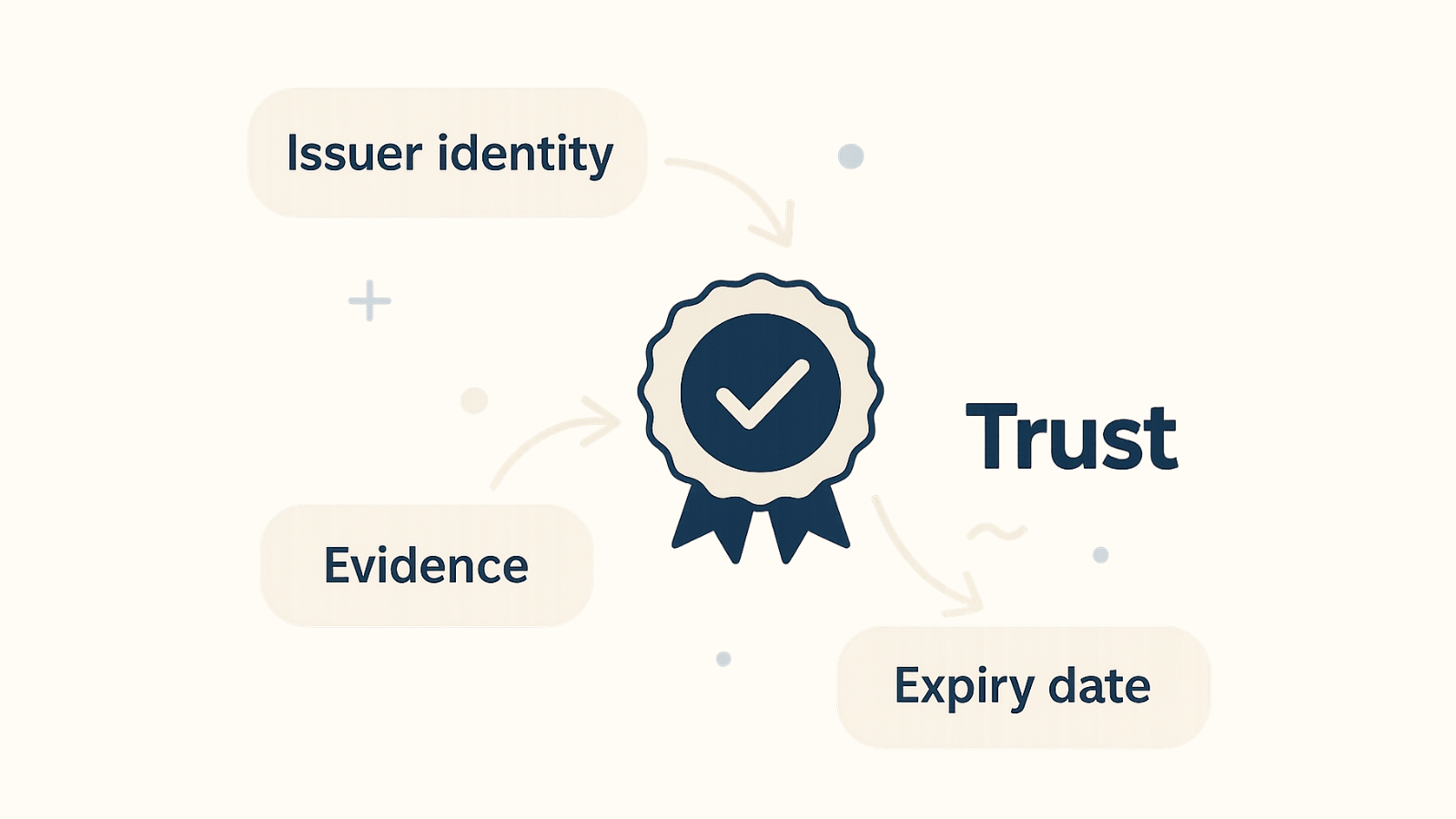Digital badges have become the quiet workhorses of modern learning. They travel faster than transcripts, fit neatly into LinkedIn profiles and communicate skills in ways that old documents never could. Yet not all badges are created equal. Some look impressive but fall apart the moment someone tries to verify them. Others carry a kind of structural honesty that makes employers trust them within seconds.
This guide unpacks what separates a nice looking badge from a truly verifiable badge, why the difference matters in 2025 and how institutions can design badges that trigger instant trust rather than polite confusion.
If you have ever wondered why a badge looks credible in one context but questionable in another, the answer usually hides in the details: metadata, evidence links and predictable verification patterns. Those three pieces decide whether a badge merely sits on a profile or actually works as a durable proof of achievement.
Why Verifiable Badges Matter for Learners and Institutions
A digital badge does more than visually represent a skill. It acts as a micro form of identity. Learners depend on that badge to travel across hiring platforms, LMS systems and professional spaces. Employers rely on it to make a decision quickly without sifting through paragraphs of explanation.
A verifiable badge reduces doubt. It lowers friction. It shows that an institution has standards. And perhaps most importantly, it shows that the learner earned something real.
Many institutions already use badges for recognition, but verifiable badges take the next step. They create a permanent trail that helps people understand what the badge represents, how it was earned and why it matters.
Most employers will never say it out loud, but they trust badges with clarity more than badges with design flair.
The Core Structure Behind a Verifiable Badge
Most verifiable badges share a predictable skeleton. Even though platforms present them differently, the underlying logic stays the same. When a badge loads cleanly and verifies instantly, it is usually because the following elements are in place.
Metadata is the part no learner talks about but every employer depends on. It contains the badge name, skill descriptions, issuing authority, date of issuance and details about assessment criteria. Without complete metadata, a badge becomes decoration rather than verification.
Great metadata answers questions before they are asked.
What skill was earned. How it was measured. Who issued it. Why it matters.
When metadata is missing, hiring teams hesitate. When metadata is complete, they move faster.
2. Evidence Links That Prove the Badge Is Not Just Decorative
Evidence links demonstrate what the learner actually did. These might include project summaries, portfolio items, assessment results or supervisor confirmations. Even a brief artefact adds depth.
A badge without evidence feels vague. A badge with proof becomes memorable, and it signals that the learner invested real effort.
 In a professional world crowded with templates and AI generated content, evidence restores authenticity. It gives the badge a heartbeat rather than a shape.
In a professional world crowded with templates and AI generated content, evidence restores authenticity. It gives the badge a heartbeat rather than a shape.
And because evidence and verification flow into each other, here's a quick read to get your basics straight : Why Verifiable Credentials Are Becoming a Global Standard from our blog series.
3. Badge Verification That Works Instantly
Verification should not feel like detective work. Employers expect a link that opens clearly, loads quickly and confirms the badge details without extra clicks.
Verification is the part that most people underestimate. A badge can be visually perfect and still fail verification due to hosting issues, outdated URLs or missing issuer data.
Instant verification sends three subtle signals:
- The issuer is competent
- The badge is genuine
- The learner can be trusted
 This creates what many designers call a trust ripple, where a fast verification experience improves the perception of the entire credential chain.
This creates what many designers call a trust ripple, where a fast verification experience improves the perception of the entire credential chain.
Human Factors That Influence Badge Trust Signals
Badge verification is not only about the technical bits. Human interpretation plays a surprisingly strong role. A badge can follow every rule and still feel unreliable if its trust signals are weak.
Trust signals include:
- A clearly recognizable issuer
- A stable verification link
- An on-brand badge design
- A timestamp that makes sense
- Metadata that feels complete rather than filled for formality
People decide whether to trust a badge in the first three seconds. A polished design helps, but clarity helps more.
This is where the Mindshare Loop tends to appear. When learners share badges that look modern and verify instantly, other learners feel encouraged to participate. Employers feel confident reviewing them and institutions benefit from subtle credibility.

At Hyperstack, we strengthen this loop by offering badge structures that verify consistently across CRM systems, LMS tools and digital portfolios. That consistency makes badges travel farther with less effort.
You can get a better understanding of this concept in our blog, The Mindshare loop from our blog series.
Metadata used to be simple. Badge title, description and issuer name felt sufficient. In 2025, expectations have matured. Hiring managers now look for metadata that communicates depth.
Modern metadata often includes:
- Skill frameworks
- Difficulty level
- Assessment method
- Intended audience
- Learning hours
- Evidence summaries
The goal is not to overload the badge but to give it enough clarity to stand alone. Metadata is the silent salesperson of the badge world. It does its job quietly, but it determines whether a person takes the badge seriously.
Speaking of skill frameworks or micro-credentials, here's an interesting read: Badges vs Certificates from our blog series.
Hyperstack’s Verification Engine
If your institution wants badges that verify instantly and behave predictably across platforms, Hyperstack offers a streamlined credential engine designed for high integrity metadata, evidence management and cross platform verification.
It gives teams the confidence that their badges will be understood and trusted wherever learners share them.
What Makes Verification Fail
Even good badges can break. Verification usually fails for reasons that sound small but feel significant in employer workflows.
Common causes include:
- Expired verification URLs
- Moved or deleted evidence files
- Incorrect issuer identifiers
- Broken hosting
- Missing or outdated metadata
- Platform migrations without proper redirection
Most failures are preventable. They appear when institutions focus on badge design rather than badge maintenance. In 2025, verification is no longer a checklist item. It is part of the badge’s long term identity.
Why Longevity Matters As Much As Design
A badge exists in two lifetimes: the moment it is issued and the years it follows the learner. Employers rarely forgive badges that stop working in year two or three. Longevity matters because it shows that the institution values both the learner and the skill.
Badges with strong longevity can:
- survive platform migrations
- retain evidence links
- maintain issuer identity
- load quickly on any modern device
This is where chain-anchored verification models are growing. They give badges a form of technical durability that makes them harder to tamper with and easier to validate over time.
Hyperstack supports these models without adding friction. It blends traditional verification with modern trust signals so institutions can scale safely. So yo can confidently showcase your badge in the spectrum that matters.
How Verifiable Badges Support Career Growth
When badges verify consistently, learners use them confidently in:
- Job applications
- Internal promotions
- Portfolio updates
- Professional networking
- Cross-border skill recognition
Badges become small but powerful markers that follow the learner. They tell a story about competence, seriousness and commitment.
A verifiable badge also reduces friction during screening. Recruiters see a clear skill and a clear verification trail. That saves time and increases trust.
In a sense, verifiable badges remove the guesswork from professional narratives, enforcing a base of trust.
Some Badges Speak Louder Than Others
If your institution wants badges that employers trust instantly and learners proudly share, Hyperstack offers a purpose built issuing environment with stable verification, clean metadata architecture and hybrid badge models that fit all credential strategies.
Start issuing your badges today!
FAQs
1. What exactly makes a badge verifiable
A badge becomes verifiable when its metadata, issuer identity and verification link confirm its authenticity. Evidence links strengthen the trust even further.
2. Why do some badges fail to verify
Most badges fail due to expired links, missing metadata, broken evidence files or platform migrations without proper redirects.
3. Do employers really check badge verification
Yes. Recruiters increasingly click verification links because it saves time compared to contacting institutions directly.
4. Is evidence mandatory for a credible badge
It is not mandatory, but evidence significantly improves trust. It shows what the learner actually did to earn the badge.
5. Does blockchain make a badge more verifiable
It improves credibility by adding tamper proof verification, but metadata and evidence remain equally important.